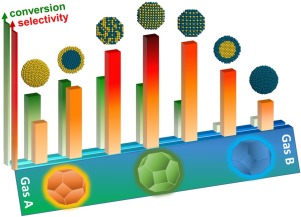当前位置:
X-MOL 学术
›
Nano Today
›
论文详情
Our official English website, www.x-mol.net, welcomes your
feedback! (Note: you will need to create a separate account there.)
Design of bimetallic catalysts and electrocatalysts through the control of reactive environments
Nano Today ( IF 13.2 ) Pub Date : 2020-04-01 , DOI: 10.1016/j.nantod.2019.100832 Yung-Tin Pan , Hong Yang
Nano Today ( IF 13.2 ) Pub Date : 2020-04-01 , DOI: 10.1016/j.nantod.2019.100832 Yung-Tin Pan , Hong Yang

|
Abstract Bimetallic nanocatalysts often exhibit enhanced performances, which are directly related to the specific atomic arrangements of the two metal elements on and near surface. It is thus important to control not only the overall but also, perhaps more critically, near surface compositions and structures. While many approaches have been developed for making bimetallic nanostructures with predetermined overall compositions, the control of surface structures with a high degree of accuracy is still a challenge. With the recent development of in situ tools such as environmental transmission electron microscopy (ETEM), dynamic structures under variable temperatures and reactive atmospheres can be studied quantitatively, laying the foundation for improved precision design of specific surface structures for catalysis. Herewith, we provide an overview of factors governing the dynamic processes of bimetallic restructuring. We first discuss the surface energetics of shaped bimetallic nanoparticles under gaseous environments, followed by examining the transformation of alloy nanoparticles into intermetallics and the key aspects in the preparation of intermetallic surfaces. Diffusion-controlled restructuring process is then presented, including the major recent developments in controlling the surface composition and formation of hollow structure from the Kirkendall process. Finally, we present selected bimetallic nanocatalysts to highlight their niche applications for electrochemical and heterogeneous reactions, especially those structurally sensitive ones, such as intermetallics, core-shell nanoparticles, and nanoframes. In situ ETEM, in this regard, can often be used to facilitate the understanding of dynamic structures under reactive conditions, thus a brief introduction is presented, focusing on the utilization of this technique in studying the bimetallic catalysts.
中文翻译:

通过控制反应环境设计双金属催化剂和电催化剂
摘要 双金属纳米催化剂通常表现出增强的性能,这与两种金属元素在表面和表面附近的特定原子排列直接相关。因此,重要的是不仅要控制整体,而且可能更重要的是控制近地表的成分和结构。虽然已经开发了许多方法来制造具有预定总体成分的双金属纳米结构,但以高精度控制表面结构仍然是一个挑战。随着环境透射电子显微镜(ETEM)等原位工具的最新发展,可以定量研究可变温度和反应气氛下的动态结构,为提高催化特定表面结构的精度设计奠定基础。特此,我们概述了控制双金属重组动态过程的因素。我们首先讨论了在气体环境下成形双金属纳米粒子的表面能量学,然后研究了合金纳米粒子向金属间化合物的转化以及金属间化合物表面制备的关键方面。然后介绍了扩散控制的重组过程,包括最近在控制 Kirkendall 过程中的表面成分和中空结构形成方面的主要进展。最后,我们介绍了选定的双金属纳米催化剂,以突出它们在电化学和多相反应中的利基应用,特别是那些结构敏感的应用,如金属间化合物、核壳纳米颗粒和纳米框架。就地 ETEM,在这方面,
更新日期:2020-04-01
中文翻译:

通过控制反应环境设计双金属催化剂和电催化剂
摘要 双金属纳米催化剂通常表现出增强的性能,这与两种金属元素在表面和表面附近的特定原子排列直接相关。因此,重要的是不仅要控制整体,而且可能更重要的是控制近地表的成分和结构。虽然已经开发了许多方法来制造具有预定总体成分的双金属纳米结构,但以高精度控制表面结构仍然是一个挑战。随着环境透射电子显微镜(ETEM)等原位工具的最新发展,可以定量研究可变温度和反应气氛下的动态结构,为提高催化特定表面结构的精度设计奠定基础。特此,我们概述了控制双金属重组动态过程的因素。我们首先讨论了在气体环境下成形双金属纳米粒子的表面能量学,然后研究了合金纳米粒子向金属间化合物的转化以及金属间化合物表面制备的关键方面。然后介绍了扩散控制的重组过程,包括最近在控制 Kirkendall 过程中的表面成分和中空结构形成方面的主要进展。最后,我们介绍了选定的双金属纳米催化剂,以突出它们在电化学和多相反应中的利基应用,特别是那些结构敏感的应用,如金属间化合物、核壳纳米颗粒和纳米框架。就地 ETEM,在这方面,











































 京公网安备 11010802027423号
京公网安备 11010802027423号